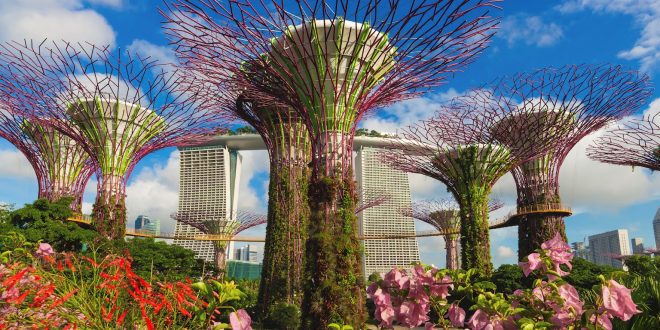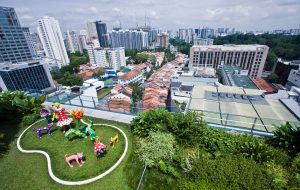Submitted by: May Leng
^Rooftop garden at Orchard Central, one among many of Singapore’s rooftop gardens
With a population density of almost 8,000 people per square kilometer, Singapore is one of the most compact cities in the world, yet the metropolis has found a way to preserve green space and reduce carbon emissions.
Over the past few years, Singapore has been incorporating construction plans and city layouts to create the idea of “liveable density”, which Cheong Koon Hean, CEO of the Housing and Development Board, describes as “creating quality of life despite [the city’s] density.” Parks brimming with green foliage and blue elements, such as rivers and ponds, are abundant and interspersed between tall buildings to create the illusion of space. Bishan Park is one of the city’s largest parks and spans 150 acres. Singapore is also beginning to connect all of their parks together with bridges to add onto the spacious ambiance while also forming 400 miles of continuous paths for walking or biking.
^Supertree Grove
Over three million trees populate the city, including an impressive rainforest. Recently, nature is even becoming a part of the architecture: vertically woven into walls of buildings, rooftop gardens, and small parks or green spaces built into towering apartment buildings. Singapore’s famous “Supertrees” boast this blend of architectural ingenuity and nature that provides a spectacle for residents while also being sustainable. These metal trees have solar panels that power their lights at night and their trunks carry cascading vertical gardens of more than 150,000 plants. The enormous Pinnacle@Duxton public housing complex composed of seven 50-story towers are connected with sky gardens that span 1,600 feet where people can socialize and form tightly knit communities within the apartment.
The metropolis also highly values keeping environmentally friendly standards, especially with construction. All of the developments at Marina Bay, a modern, tech-savvy city extension, comply with a 100% greenery replacement policy that vows to replace every area of vegetation lost with emerging buildings.
The incredible innovation of Singapore and its wild success in both satisfied citizens while remaining eco-friendly should inspire other dense cities to follow the initiative and introduce some green into the scene!
 Tempus Magazine By Students, For Students
Tempus Magazine By Students, For Students 





